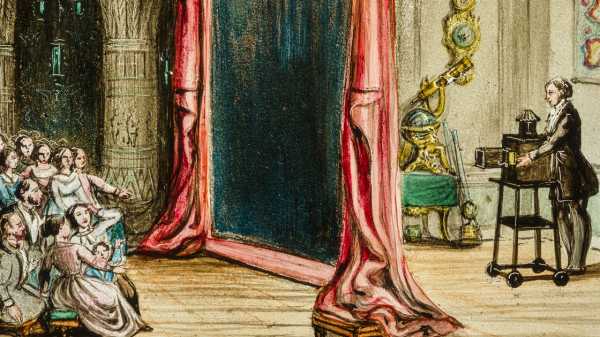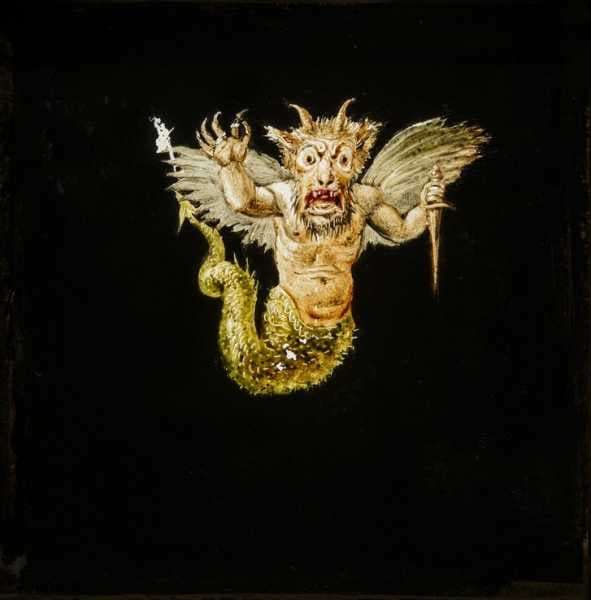
At the end of last year, Dick Balzer, the former chairman of the Magic Lantern Society of the United States and Canada, and Mervyn Heard, the former chairman of the Magic Lantern Society of Great Britain, died, a few weeks apart. They were great friends of each other, and good friends of mine.
I met them on the same day, more than thirty years ago. At the time, Leslie Cole was the only full-time collector I knew. He was a wealthy, retired director of an advertising firm, and his life’s work seemed to be pushing a shopping cart among the stalls of London’s Portobello Road antique market. Dealers stocked up during the week and awaited his arrival and his checkbook. He filled his rickety conveyance with treasures from purveyors in a number of genres: magic, primarily (he was the historian of the Magic Circle of London); the circus, of which he was a true enthusiast; and the lesser-known world of magic lanterns and pre-cinema devices and literature. Although I was largely bereft of funds, these three areas also interested me. On my trips to London, I often helped Leslie (I was some thirty-five years his junior) load his cart and hoist his plunder.
Sadly, amid many good qualities, he was a true hoarder—trying to trade him an important book that he did not have for one that I needed, and that he owned in eight identical copies, always elicited an impassioned “No,” with some practiced caveat, like, “Well, you’ve never lived through the Depression.” Nevertheless, I shall always be grateful for his insistence that I accompany him to an annual meeting of lanternists.
The magic lantern was basically a seventeenth-century slide projector: a light source (a candle), an image (a piece of painted glass), and a lens. It was an ever-evolving object, and revolutionized the way pictures were seen by an audience. It is often called a precursor to cinema, but it might better be characterized as an enabler that paved the way for film and gave rise to its own powerful visual culture. Many technical devices that explored projected imagery and the persistence of vision are sought, researched, and discussed by lantern aficionados.
The annual meeting, held in London, was captivating. It was a feast for the eyes and the ears, and for lovers of language. The display of apparatuses from “Z” to “Z” consisted of zoetropes, phenakistoscopes, prancinoscopes, tachyscopes, and zograscopes. There were anamorphic drawings and peepshows and panoramas. There were talks and demonstrations and even a performance of a nineteenth-century-style lantern slide show on Spiritualism that I thought terrific. After a break for dinner, the proceedings were to continue with an auction of lantern artifacts for “members only.” My companion persuaded me to join. It was far better organized and accomplished than most of the magic-club events I had attended since childhood. I unhesitatingly ponied up my ten pounds, received a receipt, and became a member.

Dick Balzer’s remarkable collection was displayed in an elegant private museum, in the carriage house behind his home.
Artwork courtesy The Museum of Fine Arts, Boston / The Richard Balzer Collection
A few minutes later, a rare miniature nineteenth-century lantern was offered as a door prize. The president of the Magic Lantern Society of the United States was introduced, and was asked to select the winning ticket from a drum. He sported a big smile, a big cigar, and a swagger, conspicuously unlike his more subdued compatriots. No one was more surprised than I when he read my number. I had never won anything, and to this day I have never won anything else. I walked to the front to receive my prize. I was awarded the diminutive lantern and the accompanying slides in their original case, and I smiled broadly. As I walked back to my chair, a gent from Yorkshire (I figured from his pronounced Northern accent) snickered his displeasure in a loud stage whisper: “Well, that’s outta the coun-tree, then.”
Mr. Balzer (the “American president”) and I shared a hearty laugh and instantly became friends. The showman who gave the presentation on Spiritualism was Mervyn Heard, who turned out to be a longtime friend of Balzer’s. He also became my friend. When the two men died a few months ago the lantern world lost, almost simultaneously, two of its greatest ambassadors. Both were respected collectors, performers, educators, and authors.
Balzer, who was born in 1944, was one of the most remarkable people I ever met. He lived a polymathic existence: a graduate of Cornell and of Yale Law School, he started a firm that consulted and coached the C.E.O.s of numerous global companies. (He travelled more than any of my peripatetic friends in show business, and visited more than eighty countries.) He was a photographer, and his work hangs in the Corcoran Gallery of Art and the Smithsonian; he also wrote several books on photography. He was active in VISTA, the national anti-poverty service program, and in the civil-rights movement. According to an F.B.I. account, he was also the official photographer of the Black Panthers during the trial of Bobby Seale. He was the co-founder of the Petra Foundation, which established fellowships for people combatting social injustice, and was a senior fellow at the Harvard Kennedy School of Government.
Balzer was a flâneur who deftly performed and exhibited his rarities. He wrote “Optical Amusements: Magic Lanterns and Other Transforming Images,” an early catalogue of his collection, in 1987, and Abrams published his “Peepshows: A Visual History,” in 1998. His remarkable collection was displayed in an elegant private museum, set up in the carriage house behind his home, in Brookline, Massachusetts.
A magic lanternist, Heard, who was born in 1948, was the practitioner of a rare vocation. This was in pointed contrast to the former popularity of his profession (one survey lists some twelve hundred lantern lecturers between the eighteen-sixties and the eighteen-nineties in England alone). Most people fail to understand that successful lantern shows were less a technical demonstration than an example of the showman’s art, and Heard was the most entertaining exponent I witnessed. He plied his trade in a wide variety of venues, including the Royal Opera House and the Tate Britain. He appeared around the world at theatres, cinema symposiums, and, occasionally, on film and television. His academic interest in his field prompted him to return to school, and he received his doctorate from the University of Exeter’s Department of Drama. This led to his seminal book “Phantasmagoria: The Secret Life of the Magic Lantern,” published in 2006.
It was phantasmagoria, projected ghost and horror shows popular in the eighteenth and early nineteenth centuries, that most intrigued Heard, Balzer, and me. With a cast of characters ranging from a cult quack who induced his followers to fast and to drink drugged potions before witnessing his covert lantern projections, to stage magicians who presented their shows within the parameters of frightening sets and with fearsome sound effects, to scientific lecturers and theatrical opportunists, these phantasmagoria shows conjured ghosts, devils, and even controversial politicians of the day, for audiences that had never experienced the like. The impact of these shows can still be seen in live performances and, of course, in the current cinema. The influence of these men on their field, and on me, will continue for years to come.
The Museum of Fine Art in Boston presents the exhibition “Phantasmagoria,” which features the Richard Balzer Collection, until May 28, 2018.
Sourse: newyorker.com






